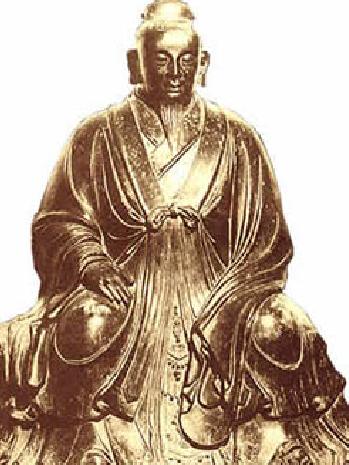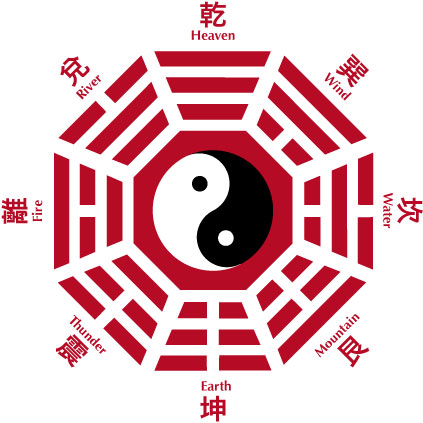THIRTEEN TECHNIQUES, BAGUA AND WUXING

The Immortal Zhang San Feng
When you practice the 72 patterns of Taijiquan, you must constantly integrate them with spirit and energy, otherwise you will only perform their external form, missing their essence.
What are the 72 patterns of Taijiquan? They are the 72 patterns found in the Wudang Taijiquan set shown here.
But aren't there 140 patterns shown in the set? Many of the patterns are transitional and repeated. Basically there are 72 patterns as follows:
Sequence 1
- Nebula Evolving Round
- Cosmos First Emerges
- Riding Horse Ask Way
- Open Window Look at Moon
- Golden Tortoise Exposes Back
- Two Saints Transit Tao
- Ape Pulls Rope
- Single Bee Sucks Pollens
- Gentle Breeze through Sleeves
- Spiritual Lion Opens Mouth
- Green Dragon Tests Claw
Sequence 2
- Old Dragon Wags Tail
- Wild Horse Charges at Stable
- White Snake Separates Grass
- Turn Over Yin-Yang
- Separate Clouds See Sun
- Big Boss Holds Elbow
- Black Tiger Steals Heart
- Receive Wind Push Door
- Carry Tiger Back to Mountain
Sequence 3
- Dark Dragon Draws Water
- Lau Chuan Presents MelonBig Boss Removes Helmet
- Against Mountain Test Cave
- Monkey Washes Face
- Din Jia Opens Mountain
- Tortoise and Snake in Combat
- Jade Gird Threads Shuttle
Sequence 4
- Circle Waist Single Hit
- Pure Blade Cuts Grass
- Golden Eagle Catches Prey
- Dark Dragon Moves Elbow
- Big Bird Circles Flowers
Sequence 5
- Move Body Change Shadow
- Lone Bird Emerges from Flock
- Swallow Skips Water
- Empty River Upturn Sea
- Dark Phoenix Looks at Sun
- Lovely Horse Flying Kicks
- Reverse Slipping of Boat
- Moving Boat Shift Rudder
- Black Bear Opens Mouth
- Yellow Bird Nips Vegetable
- Sword Chops Turtle’s Head
Sequence 6
- Numerous Bees at Top
- Tame Tiger Low Stance
- White Snake Shoots Venom
- Thousands Tons to Ground
- Ride Horse Lift Spear
- Black Bear Moves Shoulders
- Black Bears Circles Palms
- Black Bear Cloud Palms
- Carry Cosmos Maintain One
- Lion Turns Body
- Birch Tree Hangs High
Sequence 7
- Wide Clouds at Purple Summit
- Swallow Through Clouds
- Change Flower Plant Wood
- Golden Eagle Spreads Wings
- Lion Plays with Ball
- Dark Dragon Wraps Body
- Golden Snake Circulates Willow
Sequence 8
- Cloud Hands Eagle Claws
- Lion Rolls Ball
- Swallow Spreads Wings
- Yellow Dragon Emerges from Cave
- Old Eagle Catches Snake
- Old Eagle Charges at Prey
- Southern Rock Thunder Sounds
- Heaven Pillar Welcomes Sun
- Wind Wheel Chop Palm
- Garments Receive Flowing Breeze

Riding Horse Ask Way
In the 72 patterns of Taijiquan are found 13 techniques. They are as follows:
- Ward off as in "Riding Horse Ask Way"
- Roll back as in "Turn Over Yin-Yang"
- Press in as in "Against Mountain Test Cave"
- In Contact as in "Open Window Look at Moon"
- Take as in "Old Eagle Catches Snake"
- Spread as in "Golden Eagle Spreads Wings"
- Elbow as in "Big Boss Holds Elbow"
- Anchor as in "Carry Tiger Back to Mountain"
- Moving Forward as in "Green Dragon Tests Claw"
- Moving Backward as in "White Snake Separates Grass"
- Moving to Left as in "Change Flower Plant Wood"
- Moving to Right as in "Separate Clunds See Sun"
- Remaining at Centre as in "Single Bee Sucks Pollens"
These 13 techniques in the 72 patterns of Taijiquan must be performed in according to the principles of creation and reaction of the Eight Trigrams or Bagua, and of the Five Elemental Processes or Wuxing. What is Bagua, and what is Wuxing?
There are countless forms and countless processes in the phenomenal world. But all the countless forms are generalized into Eight Archetypical Forms, called Bagua in Chinese, and all the countless processes are generalized into Five Elemental Processes, called Wuxing.
The Eight Archetypical Forms or Bagua are:
- Qian -- symbolized by Heaven
- Kun -- symbolized by Earth
- Kan -- symbolized by Water
- Li -- symbolized by Fire
- Sun -- symbolized by Wind
- Zhen -- symbolized by Thunder
- Dui -- symbolized by Marsh
- Gen -- symbolized by Mountain
Please note that the term "qian" is not the Chinese word for "heaven". The Chinese word for "heaven" is "tien". "Qian" refers to a "gua" or trigram with three unbroken horizontal strokes. It is symbolized as "heaven". Sometimes it may be symbolized as "father". (The Chinese word for father is "fu".) The characteristics of heaven and father are majesty, authority and being above, and these characteristics are represented by the trigram "qian".
The Five Elemental Processes or Wuxing are:
- Metal -- characterized by being sonorous
- Water -- characterized by being spreading
- Wood -- characterized by being growing
- Fire -- characterized by being rising
- Earth -- characterized by being centring

Bagua or the Eight Archetypal Forms. Picture reproduced from http://www.nationsonline.org/oneworld/Chinese_Customs/bagua.htm
"Metal" does not literally refer to metal. It refers to processes that have the characteristics of metal. For example, when we say that the lungs are related to "metal", we do not mean that the lungs are made of metal. We mean that the lungs have the characteristics of metal, like being sonorous.
Wuxing has been traditionally translated as "Five Elements" by many writers. This is a mistake. "Xing" in "Wuxing" actually does not refer to "element" or substance. It is non-substantial; it refers to process or movement.
Again, it is important to bear in mind that these eight forms and five processes are symbolic. Many people, including some writers who translated literally from Chinese classics, fail to realize this point, resulting in much confusion and mis-understanding.
What is meant by saying that the Taijiquan patterns must be performed according to the creation and recreation principles of Bagua and Wuxing. Basically it means that Taijiquan patterns are not static and stereotype; they are fluid and alive, capable of changing their forms or movements for the particular situations.
For example, the pattern "Golden Eagle Spreads Wings" is majestic looking, and it involves expanding movement. Using Bagua principles, we may symbolize it as a "qian" or "heaven" pattern. But if the situation warrants it, we may perform this "qian" pattern in a receptive, yielding manner, which are symbolized by "kun", representing "earth”. We should not say, "You should spread out your hands and look majestic in this pattern. How can you sink in your chest and yield."
If an opponent charges in ferociously to attack using a powerful pattern "Black Tiger Steals Heart", employing the principles of Wuxing, we may classify his attacking movement as "fire". As "water" overcomes "fire", we can use the spreading movement of the pattern "Riding Horse Ask Way" to neutralize his attack. On the other hand, if an opponent uses "Riding Horse Ask Way" on us, we may counter with "Black Tiger Steals Heart".
Someone with shallow understanding may say, "Riding Horse Ask Way" is meant to counter "Black Tiger Steals Heart", like water is meant to overcome fire. How can you reverse the process, using "Black Tiger Steals Heart" to overcome "Riding Horse Ask Way", which is using "fire" to overcome "water"? This is being stereotype, due to failing to understanding the inter-reaction of Wuxing. In normal situations, water extinguishes fire. But in special situations, like when the fire is very big, or the water is insufficient, fire can dry up water.
The interactions of Bagua and Wuxing operate in everyday life. In normal situation, a manager, is authoritative, symbolized as "quan" or "heaven" in Bagua, and his workers are receptive, symbolized as "kun" or "earth". But in special situations, like when there is a labour shortage, a smart manager would be receptive to his workers’ demands. It would be unwise of him if he thinks, "I am the manager, I must always be authoritative."
When an argument is about to erupt, symbolized as "fire" in Wuxing, walking away, symbolized as "water", can diffuse the argument. This is the operation of "water overcoming fire". When followers are about to walk away, symbolized as "water", a capable leader can raise his voice, symbolized as "fire", and confidently ask them to stay. This is the operation of "abundant fire overcomes insufficient water."
Wong Kiew Kit
28th August 2011
Taragona, Spain

Wuxing or Five Elemental Processes. Picture reproduced from http://www.masterdiieso.net/public_html/Fengshui/english/05_fs_3a_wuxing.htm
LINKS
